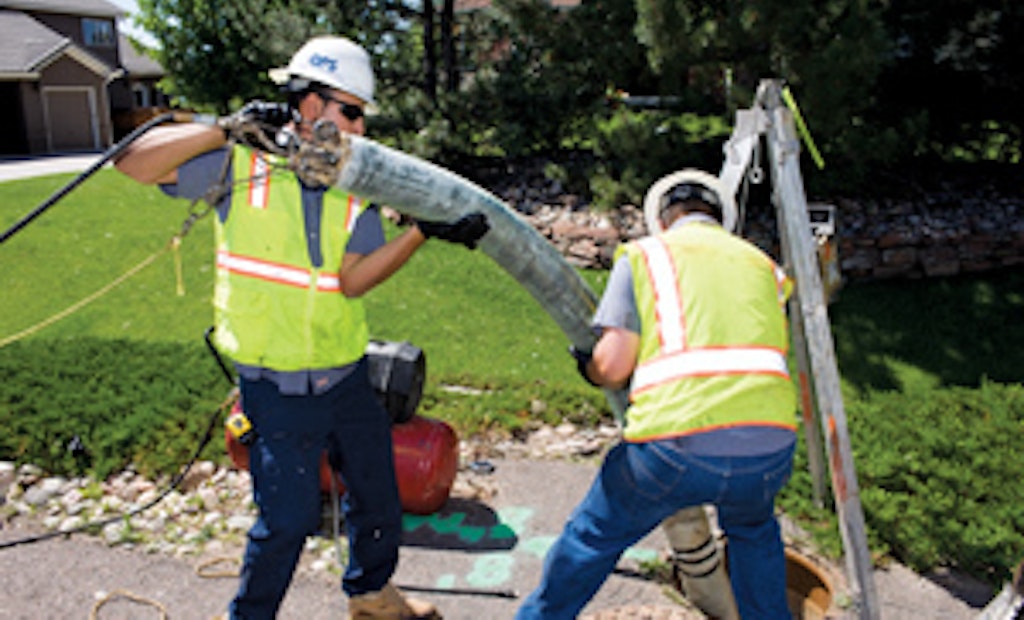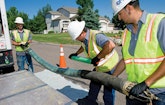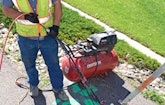
Interested in Municipal/Industrial?
Get Municipal/Industrial articles, news and videos right in your inbox! Sign up now.
Municipal/Industrial + Get AlertsWhile the nation’s economy went from boom to nearly bust after the turn of the new century, Quality Pipe Services has managed impressive growth, fed by expanding services and diversification.
“We started out working for general contractors during the housing boom,” says owner and President Scott Boyd, who founded the company in 1999. His next market choice was much more stable.
“In 2006-07, we started concentrating more on municipalities with jetting, TV inspection, and infrastructure testing and repair, anything cities needed,” he says. “No matter what the economy is like, they need to do maintenance on their infrastructure.”
Not willing to stand still, in 2008, Quality Pipe Services added service laterals to its cured-in-place pipe (CIPP) lining along with CIPP for point repair. Manhole rehabilitation followed in 2009. “We’ve grown steadily,” says Boyd. “We had a couple of years of ups and downs, but we’ve grown each year and expanded our geographic area. We’ve grown 200 percent in the past 12 months.”
Operating from Denver, the company now has business licenses in 18 states – nearly every state west of the Mississippi River. “Our employees travel the majority of the time, and we’re opening an office in Houston,” says Boyd. “The majority of our work right now is in Colorado and Texas.”
Diverse fleet
The company’s 40 employees have access to a large fleet of equipment located in California, Colorado, Montana, New Mexico, Utah, Texas and Wyoming. That includes seven inspection trucks (CUES, Aries Industries) and seven Vactor combination trucks that work in pairs on cleaning/inspection projects, a Sprayroq sealant spray rig for manhole rehabilitation, CIPP lining trailers from BLD Services, and a pipe vacuum/pressure testing system using plugs and equipment from Cherne Industries, along with dump trucks, backhoes and pickup trucks.
For high-pressure pipe cleaning and vacuuming, crews use Vactor 2100 units, and the company uses the KEG 400 chain cutter from KEG Technologies to remove roots and other debris. Along with installation and emergency repair of water and sewer lines, the company offers fire hydrant installation and repair and water valve maintenance, including management of testing data.
Despite all the technology at the company’s disposal, CEO Marlea Tichy says the most important part of the business is being there to help customers solve their problems and developing relationships.
“We’ve become a full-service problem solver by being committed to the success of our clients,” says Tichy, who joined the company in spring 2011. Boyd adds, “That’s why we got into the different services – to meet the needs customers have without dealing with four or five contractors at once. It makes their lives a little bit easier.”
He started the company to make a difference: “I’m very passionate about this industry and helping customers.” That includes wireless capabilities on inspection trucks to quickly download test videos using WinCan data acquisition equipment and software. “Our trucks can be anywhere in the United States and still get video delivered daily to customers if they want,” says Boyd. “That data is the most important thing to the engineers and cities.”
CIPP saves
CIPP lining has been around for nearly four decades and has proven cost-effective in many ways over other pipe repair techniques. “Streets aren’t torn up, traffic lanes aren’t closed,” says Tichy. CIPP lining also takes less time: “If you’re using open cutting to redo a street full of laterals, it would take you a week or two. We can go in with CIPP and do it in a couple of hours.”
Quality Pipe Services expanded on its CIPP point repairs by offering sewer lateral lining and this year became the west coast installer for BLD Services as part of a strategic partnership. The point repair system is available in diameters of 6 to 24 inches and in lengths up to 12 feet. “Cities and the EPA are recognizing that more than 60 percent of problems in wastewater inflow and infiltration come from the laterals,” says Tichy. “It’s a need that’s just going to grow.”
That growth, adds Boyd, will probably be on a large scale. “It’s going to be a huge revenue stream because a majority of cities are starting to pay attention to laterals,” he says. “They’re recognizing the need to repair not only the mainlines, but also the laterals, where you get the leakage and roots that eventually cause problems in the main.”
CIPP work in laterals is just like working in a main, using felt liner material infused with polyester, vinyl ester or epoxy resin. The material is moved into position on an inflatable rubber bladder. “When it is pressurized,” says Tichy, “it either seals up against the main for a point repair, or expands up the lateral.”
The inflated bladder holds the felt in place for 30 to 45 minutes while the resin cures with ambient temperatures.
Growth in manhole rehab
Last year, Boyd recognized that manhole repair was becoming more important to his customers. “The gases eat away at the concrete and cause it to crumble; manholes have been neglected over the years,” he says. “If cities are rehabbing their system, the manholes are just as important as the mainlines.”
This repair is also no-dig. “It’s more cost-effective when you’re doing the work from the inside,” says Boyd. “You don’t have to dig up the manhole and replace it; you can put the structural liner in there and it’s going to last another 50 to 100 years.”
The company offers manhole rehabilitation with Sprayroq spray-applied polyurethane and DINJER mortar (WBE Dorcas), epoxy gel and inflow inserts.
Tichy says it’s exciting to be able to solve society’s problems. “Infrastructure work isn’t glamorous or glitzy, but whether you’re turning on your faucet or flushing your toilet, everyone needs our services,” she says. “With the tight budgets of our customers, we can come in and brainstorm ideas and provide customized solutions that fit the budget, rather than selling a particular product or service.”
High potential
Municipalities have become more proactive with maintenance, according to Boyd. “I don’t think those big budgets with all the equipment and people are going to come back,” he says. “I see a lot more outsourcing of maintenance. The downturn of the economy affected everything and I think it’s going to change the way people think.”
New regulations are also a big driver, according to Tichy: “They figure they’re going to have to pay now or pay later, so they may as well fix it instead of risking fines or a consent order.”
She says some customers feel they have a responsibility to go beyond the regulations to protect their systems and prevent emergencies. “The cost of calling everyone out at the last minute, potentially in the middle of the night or during a storm, and trying to fix it then and there; you have no choices at that point,” she says. “You’re digging and replacing and finding materials at the last minute. There’s a really high premium that comes with that.”
For customers, it comes down to wise use of dollars. “If you have a maintenance program, you’re videoing your pipes and assessing them, and you end up with a rating system to prioritize the work; those are the most important steps to decide where best to spend the money,” says Tichy.
Quality Pipe Services’ approach is to offer all the services a customer needs to make decisions about what to fix, and then to fix it. Boyd thinks the company’s approach will allow it to continue to grow quickly. “I think we could probably reach as many as 200 to 300 employees over the next three to five years,” he says. “We’re on a pretty aggressive growth plan.”









